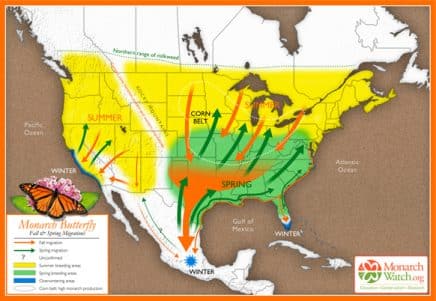©2025 Operation Brightside Inc. | All marks are trademarks of their respective owners.
We need your help.
Your donations allow us to do what we do. Please help!
Contact us to learn about our
St. Louis volunteer opportunities.
Get our e-newsletter.
The Fall Monarch Migration is Underway!
The Fall Monarch Migration is Underway!
In the past few weeks, monarch butterflies have flocked to Brightside’s Demonstration Garden and hundreds of monarch gardens all over St. Louis. We have seen many butterflies and even a handful of caterpillars on our milkweed.
With the days shortening, the monarchs know that it is time to make their long annual journey back to Mexico for the winter. While summer monarchs only live for 2-6 weeks, the migratory and over-wintering monarchs can live for up to eight months. In order to survive the journey and the entire winter in Mexico, they begin changing their behavior and physiology:
- When they emerge from their chrysalis, the fall migratory monarchs are in diapause, meaning their reproductive development pauses until spring, when they will mate in Mexico. The hormonal deficiency that allows monarchs to remain in diapause is what contributes to the increased lifespan.
- In order to store fat for the winter, the adult butterflies feed heavily on nectar-producing plants.
- Migratory butterflies begin moving in directional flight and clustering in overnight roosts, usually in trees.
Although we are seeing lots of monarchs right now, their population is still in trouble. Since the 1990s, we have lost more than 90% of the monarch population. This is in large part due to habitat loss, both in the United States and in Mexico.
What you can do:
Plant milkweed: The most essential plant for monarchs is milkweed, which is the only plant the female butterfly lays her eggs on and the only plant that the caterpillars eat. Without milkweed, we cannot have monarchs.
Add nectar-producing plants with a variety of bloom times to your garden: Since monarchs migrate through the St. Louis area in both spring and fall, it is important that they have a food source for both legs of their journey. For the fall migration, we recommend using varieties of aster and goldenrod.
Avoid using pesticides & insecticides in your garden: Pesticides are not selective, so spraying for one type of insect can have adverse effects on all of them, including monarchs and beneficial pollinators. When purchasing plants for your garden, it is also advantageous to make sure the plants have not been pre-treated with insecticides like neonicotinoids.
Report your sightings: Citizen science can help inform researchers of migratory patterns and population boosts or declines. Reporting your sightings of all stages of the monarch life cycle to organizations like Journey North is a fun way to engage with citizen science programs while also contributing to larger research efforts. Here’s what to look for:
- Eggs: Look under milkweed leaves to find monarch eggs. These eggs are only about the size of a pinhead, so look closely!
- Caterpillars: Caterpillars will almost always be found on milkweed plants. They may be different sizes, ranging from two millimeters to almost two inches. These sizes indicate different stages of the caterpillar’s life, called instars.
- Chrysalises: Small green chrysalises can be found on milkweed or on other plants. Some people even find them on window sills or the siding of their houses!
- Butterflies: Most people can easily recognize the iconic orange and black monarch butterflies. If you look closely, you can determine whether the butterfly is a male or female. Male monarchs have small black scent spots on their hind wings, which help them attract female butterflies. Females don’t have these spots but have wider black veins on their wings.




We found 17 eggs which are now caterpillars of varying sizes. An egg left in the wild has a 10% chance of making it to butterfly. The odds reverse if you protect the egg and raise the caterpillars, and release the butterflies. There are several good sites for advise if you plan to go that route.
I have only seen 2 butterflies in my yard this summer. I have lots of zinnias but will put in milkweed next year. Even without milkweed they alway seemed to like the zinnias.
We have two large caterpillars on our milkweed, and more smaller ones. We also have yellow swallowtails on our other flowering plants.
We were at Indiana Dunes State park and watched 100’s of butterflies go by! It was amazing! September 15.